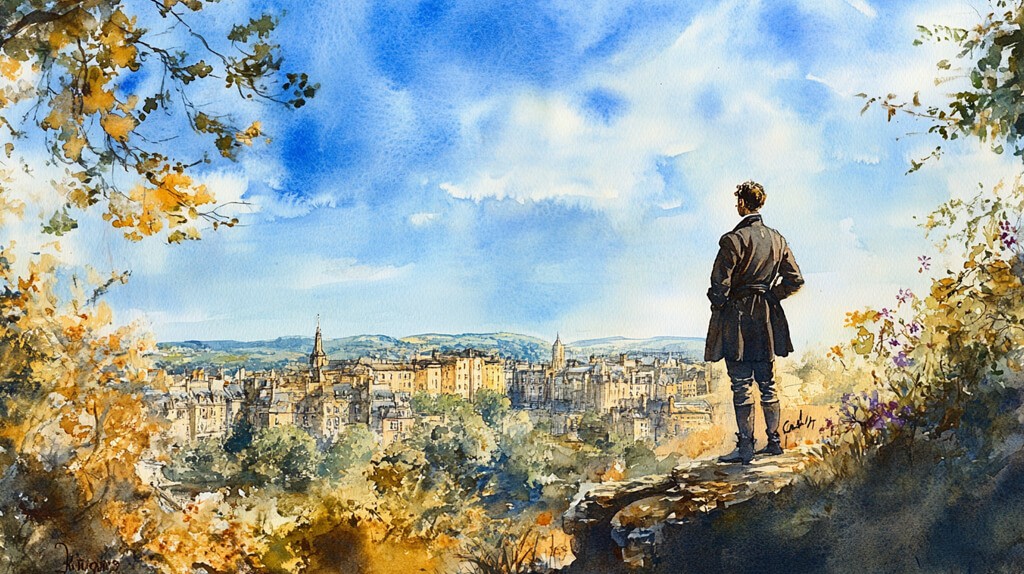The Story Behind: For the Beauty of the Earth
A spring morning in Bath, England, 1864. Violets and primroses dotted the rolling countryside as a young man sat atop a hill, taking in God’s creation. That man was Folliott Sandford Pierpoint, and the beauty before him stirred his soul to write one of Christianity’s most beloved hymns of gratitude.
Early Life and Education
Born in Bath, England in 1835, Pierpoint showed early promise as a scholar and writer. His education led him to become an accomplished poet, and he published several collections including “The Chalice of Nature and Other Poems” (1855) and “Songs of Love.” But it was a simple morning’s observation that would lead to his most enduring work.
A Hilltop Inspiration
Pierpoint was twenty-nine years old when divine inspiration met earthly beauty. Looking out over his native city of Bath, he saw more than just the natural splendor – he saw evidence of God’s love manifest in creation itself. The words that would become “For the Beauty of the Earth” flowed from his pen, each verse a celebration of different aspects of God’s goodness:
For the beauty of the earth,
For the beauty of the skies,
For the love which from our birth
Over and around us lies.
The Original Purpose
The hymn was originally written for communion services, published in a collection called “Lyra Eucharistica” – fittingly, as “Eucharist” derives from a Greek root meaning ‘grateful.’ Pierpoint crafted eight verses that followed a beautiful progression – from the physical beauty of creation to the spiritual beauty of the Church. His original refrain, “Christ, our God, to Thee we raise / This our sacrifice of praise,” drew inspiration from both the Book of Common Prayer’s post-Communion prayer and the Biblical text of Hebrews, connecting the hymn deeply to its eucharistic roots.
Evolution of the Text
While the editors of Hymns Ancient & Modern claimed their revisions were approved by the author, Pierpoint preferred his original version. When asked about the phrase “Christ our God” in the refrain, which many hymnals had changed to “Father, unto Thee,” Pierpoint simply noted: “Pliny in his letter to the Emperor said the Christians, when meeting in worship, sang a hymn to Christ as God. As the only public service of the Church was the daily Eucharist, I addressed my hymn to ‘Christ, our God.’”
The hymn has seen numerous variations across denominations, with the fifth verse being almost completely rewritten in many hymnals. These variations mean that the version one congregation knows and loves might be quite different from what’s sung in a neighboring church. Yet somehow, these differences have only served to make the hymn more accessible to a broader range of worshippers.
The Melody’s Journey
The tune that carries these words of praise has its own interesting history. Known as DIX, the melody was composed by Conrad Kocher in 1838 as a chorale tune for “Treuer Heiland, wir sind hir” (Faithful Savior, We are Here). The tune was later adapted by William H. Monk, who shortened the refrain by two measures. Though the tune bears William Chatterton Dix’s name, he neither wrote nor adapted it – it was simply paired with his Christmas hymn “As with Gladness Men of Old” and the name stuck.
A Unique Theological Vision
Unlike other nature-focused hymns of the era, such as Isaac Watts’ “I sing the almighty power of God” or Cecil Frances Alexander’s “All things bright and beautiful,” Pierpoint’s hymn spans a broader theological scope. It moves beyond mere appreciation of the natural world to encompass human relationships, the church, and ultimately, Christ himself. The final verse powerfully addresses Christ as the “best Gift Divine,” concluding with an echo of Luke 2:14’s cosmic connection between heaven and earth:
For thyself, best Gift Divine,
to the world so freely given,
for that great, great love of thine,
peace on earth, and joy in heaven.
Impact Through the Ages
The hymn’s influence has grown far beyond what Pierpoint might have imagined. Published in over 450 hymnals across different denominations, it has become particularly beloved during the Thanksgiving season in America. When autumn leaves paint the landscape in vibrant hues and harvests are gathered in, congregations across the nation lift their voices in Pierpoint’s words of gratitude.
Modern arrangements have given the hymn new life, including John Rutter’s popular choral setting with a new melody composed in 1978. This arrangement has helped introduce the hymn to new generations, proving that its message of gratitude remains as relevant today as it was in 1864.
A Lasting Legacy
That spring morning in Bath, when a young poet looked out over his hometown and saw God’s handiwork in every detail, has echoed through generations. Whether sung in its original eucharistic context or as a hymn of general thanksgiving, “For the Beauty of the Earth” continues to give voice to the grateful heart’s desire to praise. It reminds us that every good gift – from the smallest flower to the vastness of human love – comes from above and deserves our praise.
“For everything God created is good, and nothing is to be rejected if it is received with thanksgiving.” – 1 Timothy 4:4
Download sheet music, chord charts, tracks and multitracks for For the Beauty of the Earth exclusively at Hymncharts.com and Worshiphymns.com. You won’t find this arrangement on any other websites.



